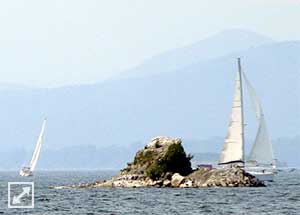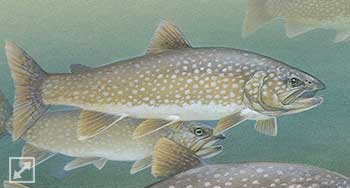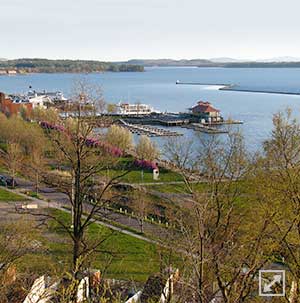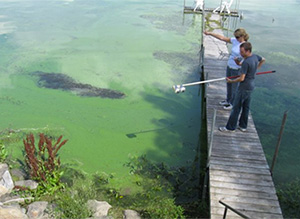Focal Places in Burlington
The Waterfront : Under the Water
“Odzihozo”
From the Burlington shoreline, a far-off speck disrupts the smooth surface of the water between Shelburne Point and Juniper Island. An orca fin? A submarine? Champ? According to Abenaki legend, this is Odzihozo.

"Odzihozo" (also Dunder Rock) in Lake Champlain,
by Jim Millard, Panoramio
Odzihozo is the Transformer, "He Who Shaped Himself." From his position at present-day Lake Champlain, he formed his body and then used his hands to pull up the Adirondacks to the West and the Green Mountains to the East, carving out river valleys with his fingertips. As he rose to walk, the impression left by his body formed the lake itself, his legs extending to the north on either side of the Champlain Islands. He was so pleased with his work that he transformed himself into a rock near Burlington Bay, where he could continue to admire the result through the ages.
Boaters continue to leave offerings for Odzihozo, or Dunder Rock, to ensure safe passage across the lake.
Phosphorus
Phosphorus is a limiting nutrient for plants in naturally oligotrophic lakes like much of Lake Champlain. However, due to phosphorous pollution from run-off, poor waste management and manure, phosphorus levels in many parts Lake Champlain have skyrocketed. This can stimulate unhealthy blue green algae blooms that threaten the health of the lake and its animal, human and plant inhabitants. The Lake Champlain Basin Program offers comprehensive information on the effects of phosphorus in the lake and the basin communities’ efforts to reduce pollution.
Lake Trout

Lake Trout, created by artist Timothy Knepp,
US Fish and Wildlife Service National Digital Library
Lake trout were extirpated from Lake Champlain in the late 1800’s. This mass extinction could be due to overfishing, predation pressures or changes in the ecology of the lake. An extensive reintroduction program was initiated in the 1970’s by the New York and Vermont state fish and wildlife agencies. The introduced fish successfully grow in the lake and are caught every year by anglers.
Lake trout spawn on rocky features such as natural reef extending off points. They need current to keep silt off the eggs as they develop. Much of the original spawning habitat in the lake has been degraded or obliterated by human activities on the land and water. Luckily for the lake trout, many human-made structures, such as the Burlington breakwater and the Blodgett Beach docks are made from large rocks and occur in areas with current. In fact, lake trout use these structures to successfully spawn every year.
Unfortunately, despite successful spawning, the eggs and young rarely survive their first year. This could be due to high populations of predators at this particular life stage or contaminants in the water. Because so few naturally spawned eggs grow to adulthood, the introduction program has not yet become sustainable. Instead, new trout are introduced to the lake every year.
The Breakwater

View of Burlington Harbor
and the breakwater from Battery ParkAlthough you can see part of the structure above water, the largest part of the Burlington breakwater is found underwater. The breakwater in Burlington Harbor was built through a series of Congressional Acts from 1834-1875 in order to protect the harbor and the barges from waves and weather. Three main phases of construction occurred in 1836, 1866 and 1875. It was built from wooden crib structures filled with stone. At the time white pine was significantly more expensive than hemlock, so most of the structures were built with the cheaper material.
Since its main construction in the 1800’s the breakwater has undergone a series of repairs. Unstable areas were secured with stone in the early and mid-twentieth century. The stone we can see today is Barre granite and was put in place during the repairs of 1941. Most recently, the breakwater was repaired in 2001-2002 by adding more stone to the failing wooden structures. For more information, check out the Army Corps of Engineers’ page on the Burlington Harbor.
Underwater Structures
Structures built to support the thriving industrial waterfront of the mid 1800’s are not just buried under fill, they can also be found underwater. The docks that moored ships in front of the current Blodgett Building and that funneled ships into the barge canal are now part of the underwater ecosystem. In fact, the large stones that provided base structure for the docks are now being used by lake trout for spawning. Even today, at low water the structures at Blodgett beach can be seen from the shore.
